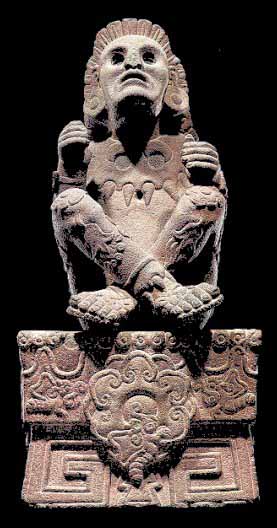
Gods and Goddesses

Gods and Goddesses
Religion was extremely important in Aztec life. They worshipped many gods and goddesses, each of whom ruled one or more human activities or aspects of nature. The people had many agricultural gods because their culture was based heavily on farming; also they included natural elements and ancestor-heroes.
Aztec religion is the Mesoamerican religion practiced by the Aztec empire. Like other Mesoamerican religions, it had elements of human sacrifice in connection with a large number of religious festivals which were held according to patterns of the Aztec calendar. It had a large and ever increasing pantheon; the Aztecs would often adopt deities of other geographic regions or peoples into their own religious practice. Aztec cosmology divided the world into upper and nether worlds, each associated with a specific set of deities and astronomical objects. Important in Aztec religion were the sun, moon and the planet Venus - all of which held different symbolic and religious meanings and were connected to deities and geographical places.
Large parts of the Aztec pantheon were inherited from previous Mesoamerican civilizations and others, such as Tlaloc, Quetzalcoatl and Tezcatlipoca, were venerated by different names in most cultures throughout the history of Mesoamerica. For the Aztecs especially important deities were Tlaloc the god of rain, Huitzilopochtli the patron god of the Mexica tribe, Quetzalcoatl the culture hero and god of civilization and order, and Tezcatlipoca the god of destiny and fortune, connected with war and sorcery. Each of these gods had their own temples within the Aztec capital Tenochtitlan - Tlaloc and Huitzilopochtli were both worshipped at the Templo Mayor. A common Aztec religious practice was the recreation of the divine: Mythological events would be ritually recreated and living persons would impersonate specific deities and be revered as a god - and often ritually sacrificed.
Teotl is a central idea of Aztec religion. The Nahuatl term is often translated as "god", but it may have held more abstract aspects of the numinous or divine, akin to the Polynesian concept of Mana. In Pipil mythology Teotl is known merely as the creator and the father of life. The nature of "Teotl" has been an ongoing discussion between scholars for many years.
Teotl is also a key element in the understanding of the fall of the Aztec empire, because it seems that the Aztec ruler Moctezuma II and the Aztecs in general referred to Cortez and the conquistadors as "Teotl" - it has been widely believed that this means that they believed them to be Gods, but a better understanding of "teotl" might suggest that they were merely seen as "mysterious" and "inexplicable".
Religion was part of all levels of Aztec society. On the state level, religion was controlled by the Tlatoani and the high priests governing the main temples in the ceremonial precinct of the Aztec capital of Tenochtitlan. This level involved the large monthly festivals and a number of specific rituals centered around the ruler dynasty and attempting to stabilize both the political and cosmic systems, these rituals were the ones that involved sacrifice of humans.
For example, on the feast of Huey Tozoztli, the ruler himself ascended Mt. Tlaloc and engaged in autosacrifice in order to petition the rains. Throughout society, each level had their own rituals and deities and played their part in the larger rituals of the community. For example the class of Pochteca merchants were involved in the feast Tlaxochimaco where the merchant deity would be celebrated and slaves bought on specific slave markets by long distance traders would be sacrificed.
On the feast of Ochpaniztli, all commoners participated in sweeping the streets, and they also undertook ritual bathing. The most spectacular ritual was the New Fire ceremony which took place every 52 years and involved every citizen of the Aztec realm, during this commoners would destroy house utensils, quench all fires and receive new fire from the bonfire on top of Mt. Huixachtlan, lit on the chest of a sacrificed person by the high priests.
The Aztec world consisted of three main parts: the earth world on which humans lived, an underworld which belonged to the dead and the upper plane in the sky. The earth and the nether world were both open for humans to enter, whereas the upper plane in the sky was impenetrable to humans. The Aztec underworld was called Mictlan ("place of death").
Existence was envisioned as straddling the two worlds in a cycle of birth, life, death and rebirth. Thus as the sun was believed to dwell in the underworld at night to rise reborn in the morning, and the maize kernels were entered later to sprout anew, so the human and divine existence was envisioned as being cyclical. The upper and nether worlds were both thought to be layered. Mictlan had nine layers which were inhabited by different deities and mythical beings.
The sky had 13 layers, the highest of which was called Omeyocan "place of duality" and which held the progenitor dual god Ometeotl. Other places were Tlalocan, "The place of Tlaloc", a verdant spring-like place with abundant water where people who drowned had their afterlife and Tamoanchan, a mythical place of the origin of the gods.they were well known
After death the soul of the Aztec went to one of three places: Tlalocan, Mictlan, and the sun. The Aztec idea of the afterlife for fallen warriors and women who died in childbirth was that their souls would be transformed into hummingbirds that would follow the sun on its journey through the sky. Souls of people who died from less glorious causes would go to Mictlan - place of the dead. Those who drowned would go to Tlalocan.
In Aztec cosmology, as in Mesoamerica in general, geographical features such as caves and mountains held symbolic value as places of crossing between the upper and nether worlds. Also the cardinal directions were symbolically connected to the religious layout of the world, each direction was associated with specific colors and Gods.
In the Nahuatl language, the word for priest was tlamacazqui meaning "giver of things" - the main responsibility of the priesthood was to make sure that the gods were given their due in the form of offerings, ceremonies and sacrifices.
The Tlatoani of Tenochtitlan was the head of the cult of Huitzilopochtli and thus of the state religion of the Aztec empire. He had special priestly duties in different rituals on the state level.
However, the Aztec religious organisation was not entirely under his authority. Sahagun and Duran describe the pairs of high priests (Quetzalcoatls) who were in charge of the major pilgrimage centres (Cholula and Tenochtitlan) as enjoying immense respect from all levels of Aztec society - akin to archbishops - and a level of authority that partly transcended national boundaries. Under these religious heads were many tiers of priests, priestesses, novices, 'nuns' and 'monks' (some part-time) who ran the cults of the various gods and goddesses. Sahagun reports that the priests had a very strict training, and had to live very austere and ethical lives involving prolonged vigils, fasts and penances. For instance, they often had to bleed themselves and undertake prescrtibed self-mortifications in the build up to sacrificial rites.
Additionally, Sahagun refers to classes of religious specialists not affiliated with the established priesthood. This included wandering curers, black magicians and other occultists (of which the Aztecs identified many types, most of which they feared) and hermits. Finally, the military orders, professions (e.g. traders - pochteca) and wards (calpulli) each operated their own lodge dedicated to their specific god. The heads of these lodges, although not full-time religious specialists, had some ritual and moral duties. Duran also describes lodge members as having the responsibility of raising sufficient goods to host the festivals of their specific patron deity. This included annually obtaining and training a suitable slave or captive to represent and die as the 'image' of their deity in that festival.
Aztec temples were basically offering mounds: solid pyramidal structures crammed with special soils, sacrifices, treasures and other offerings. Buildings around the base of the pyramid, and sometimes a small chamber under the pyramid, stored ritual items and provided lodgings and staging for priests, dancers and temple orchestras. The pyramids were buried under a new surface every several years (especially every 52 years - the Aztec century). Thus the pyramid-temples of important deities constantly grew in size.
In front of every major temple lay a large plaza. This sometimes held important ritual platforms such as the 'eagle stone' where some victims were slain. Plazas were where the bulk of worshippers gathered to watch rites and dances performed; to join in the songs and sacrifices (the audience often bled themselves during the rites) and to partake in any festival foods. Nobility sat on tiered seating under awnings around the plaza periphery, and some conducted part of the ceremonies on the temple.
Continual rebuilding enabled Tlatoani and other dignitaries to celebrate their achievements by dedicating new sculptures, monuments and other renovations to the temples. For festivals, temple steps and tiers were also festooned with flowers, banners and other decorations. Each pyramid had a flat top to accommodate dancers and priests performing rites. Close to the temple steps there was usually a sacrificial slab and braziers.
The temple house (calli) itself was relatively small, although the more important ones had high and ornately carved internal ceilings. To maintain the sanctity of the gods, these temple houses were kept fairly dark and mysterious - a characteristic that was further enhanced by having their interiors swirling with smoke from copal (incense) and the burning of offerings.
Cortes and Diaz describe these sanctuaries as containing sacred images and relics of the gods, often bejeweled but shrouded under ritual clothes and other veils, and hidden behind curtains hung with feathers and bells. Flowers and offerings (including a great amount of blood) generally covered much of the floors and walls near these images. Each image stood on a pedestal and occupied its own sanctuary. Larger temples also featured subsidiary chambers ('little houses') accommodating lesser deities.
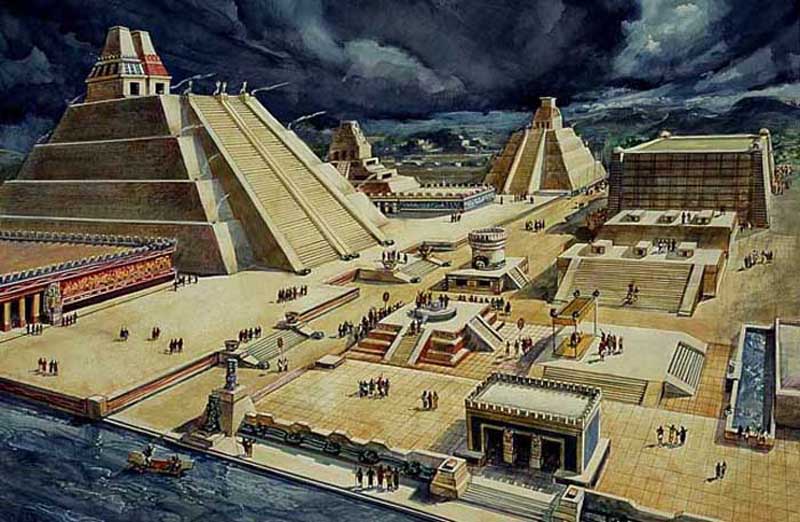
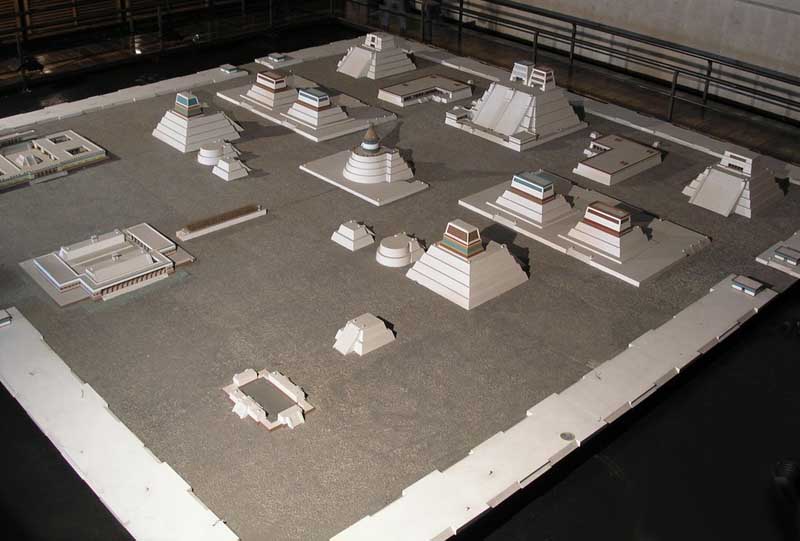
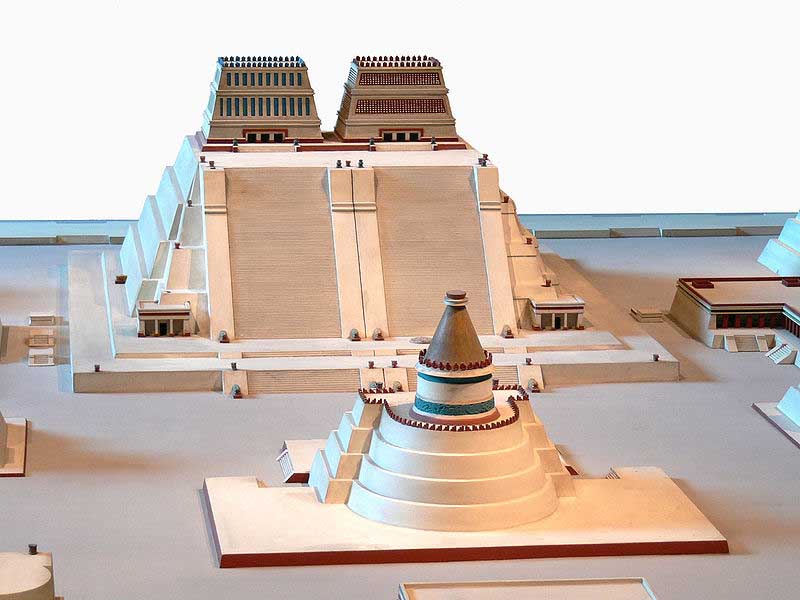
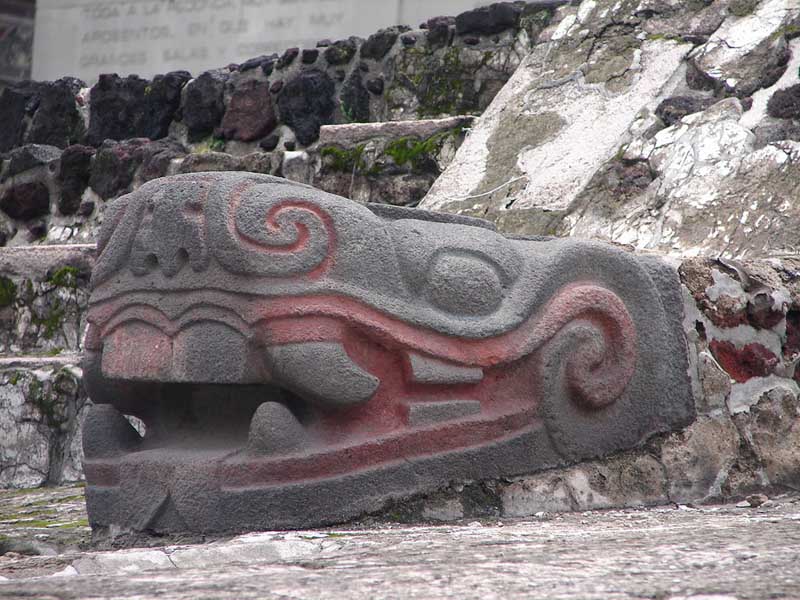
The Templo Mayor was one of the main temples of the Aztecs in their capital city of Tenochtitlan, which is now Mexico City. Its architectural style belongs to the late Postclassic period of Mesoamerica. The temple was called the huey teocalli in the Nahuatl language and dedicated simultaneously to two gods, Huitzilopochtli, god of war and Tlaloc, god of rain and agriculture, each of which had a shrine at the top of the pyramid with separate staircases. The temple, measuring approximately 100 by 80 m (330 by 260 ft) at its base, dominated a Sacred Precinct.
Construction of the first temple began sometime after 1325, and it was rebuilt six times after that. The temple was destroyed by the Spanish in 1521. The modern-day archeological site lies just to the northeast of the Zocalo, or main plaza of Mexico City, on the corner of what are now Seminario and Justo Sierra streets. The site is part of the Historic Center of Mexico City, which was added to the UNESCO World Heritage List in 1987.
After the destruction of Tenochtitlan, the Templo Mayor, like most of the rest of the city, was taken apart and then covered over by the new Spanish colonial city. The Temple’s exact location was forgotten, although by the 20th century scholars had a good idea where to look for it.
This was based on the archeological work done at the end of the 19th century and the first half of the 20th. Leopoldo Batres did some excavation work at the end of the 19th century under the Mexico City Metropolitan Cathedral because at this time, the temple was thought to be there.
In the first decades of the 20th century, Manuel Gamio found part of the southwest corner of the temple and his finds were put on public display. However, it did not generate great public interest in excavating further as the zone was an upper-class residential area.
In 1933, Emilio Cuevas found part of a staircase and beam.
In 1948, Hugo Moedano and Elma Estrada Balmori excavated a platform containing serpent heads and offerings.
In 1966, Eduardo Contreras and Jorge Angula excavated a chest containing offerings that was first explored by Gamio.
However, the push to fully excavate the site did not come until late in the 20th century. On 25 February 1978, workers for the electric company were digging at a place in the city then popularly known as the “island of the dogs.” It was named such because it was slightly elevated over the rest of the neighborhood and when there was flooding, street dogs would congregate there. At just over two meters down they struck a pre-Hispanic monolith. This stone turned out to be a huge disk of over 3.25 meters (10.6 feet) in diameter, 30 centimeters (11.8 inches) thick and weighing 8.5 tons. The relief on the stone was later determined to be Coyolxauhqui, the moon goddess, dating to the end of the 15th century.
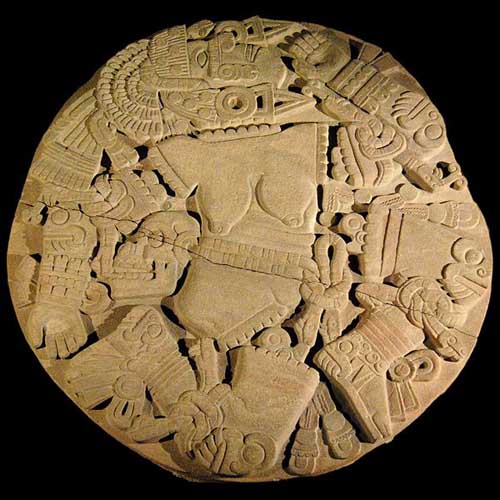
From 1978 to 1982, specialists directed by archeologist Eduardo Matos Moctezuma worked on the project to excavate the Temple. Initial excavations found that many of the artifacts were in good enough condition to study. Efforts coalesced into the Templo Mayor Project, which was authorized by presidential decree.
To excavate, thirteen buildings in this area had to be demolished. Nine of these were built in the 1930s and four dated from the 19th century, and had preserved colonial elements. During excavations, more than 7,000 objects were found, mostly offerings including effigies, clay pots in the image of Tlaloc, skeletons of turtles, frogs, crocodiles, and fish, snail shells, coral, some gold, alabaster, Mixtec figurines, ceramic urns from Veracruz, masks from what is now Guerrero state, copper rattles, decorated skulls and knives of obsidian and flint. These objects are housed in the Templo Mayor Museum. This museum is the result of the work done since the early 1980s to rescue, preserve and research the Templo Mayor, its Sacred Precinct and all objects associated with it. The museum exists to make all of the finds available to the public.
The excavated site consists of two parts, the temple itself, exposed and labeled to show its various stages of development, along with some other associated buildings, and the museum, built to house the smaller and more fragile objects.
Mexican pyramids were typically expanded by building over prior ones, using the bulk of the former as a base for the latter, as later rulers sought to expand the temple to reflect the growing greatness of the city of Tenochtitlan. Therefore, digging down through this pyramid brings us back in time. The first temple was begun by the Aztecs the year after they founded the city, and the pyramid was rebuilt six times after that. All seven stages of the Templo Mayor, except the first, have been excavated and assigned to the reigns of the emperors who were responsible for them.
Construction of the first Templo Mayor began sometime after 1325. This first pyramid is only known through historical records as the high water table of old lakebed prevents excavation. According to these records, the first pyramid was built with earth and perishable wood, which may not have survived to the present time.
The second temple was built during the reigns of Acamapichtli, Huitzilihuitl and Chimalpopoca between 1375 and 1427. The upper part of this temple has been excavated, exposing two stone shrines covered in stucco on the north side. A chacmool was uncovered as well. On the south side there is a sacrificial stone called a “techcatl”and a sculpted face.
The third temple was built between 1427 and 1440 during the reign of Itzcoatl. A staircase with eight stone standard-bearers is from this stage bearing the glyph with the year Four-Reed (1431) These standard bearers act as 'divine warriors' guarding the access to the upper shrines.
The fourth temple was constructed between 1440 and 1481 during the reigns of Moctezuma I and Axayacatl. This stage is considered to have the richest of the architectural decorations as well as sculptures. Most offerings from the excavations are from this time. The great platform was decorated with serpents and braziers, some of which are in the form of monkeys and some in the form of Tlaloc. At this time, the stairway to the shrine of Tlaloc was defined by a pair of undulating serpents and in the middle of this shrine was a small altar defined by a pair of sculpted frogs. The circular monolith of Coyolxauhqui also dates from this time.
The fifth temple (1481-1486) is dated during the short reign of Tizoc. During these five years the platform was recovered in stucco and the ceremonial plaza was paved.
The sixth temple was built during the reign of Ahuizotl. The Sacred Precinct was walled off and this wall was decorated with serpent heads. He built three shrines and the House of the Eagle Warriors. At the inauguration of this Great Temple in 1487, Ahuizotl ordered the sacrifice of many prisoners of war; an average of 1,000 victims a day were sacrificed over a period of twenty days. Each day blood ran like a river onto the pavement of the Great Plaza, and the stairs of the great pyramid were literally bathed in blood.
The seventh and last temple is what Hernan Cortes and his men saw when they arrived to Tenochtitlan in 1519. Very little of this layer remains because of the destruction the Spaniards wrought when they conquered the city. Only a platform to the north and a section of paving in the courtyard on the south side can still be seen.
Most of what is known about this temple is based on the historical record. It was at the time the largest and most important active ceremonial center. Fray Bernardino de Sahagun reports the Sacred Precinct as having 78 buildings; however, the Templo Mayor towered above all of them.
The pyramid was composed of four sloped terraces with a passage between each level, topped by a great platform that measured approximately 80 x 100 meters. It had two stairways to access the two shrines on the top platform. One was dedicated to Tlaloc, the god of water on the left side (as you face the structure), and one to Huitzilopochtli, god of war, on the right side. The two temples were approximately 30 meters in height, and each had large braziers where the sacred fires continuously burned. The entrance of each temple had statues of robust and seated men which supported the standard-bearers and banners of handmade bark paper. Each stairway was defined by balustrades flanking the stairs terminating in menacing serpent heads at the base. These stairways were used only by the priests and sacrificial victims. The entire building was originally covered with stucco and polychrome paint.
The deities were housed inside the temple, shielded from the outside by curtains. The idol of Huitzilopochtli was modeled from amaranth seeds held together with honey and human blood. Inside of him were bags containing jade, bones and amulets to give life to the god. This figure was constructed annually and it was richly dressed and fitted with a mask of gold for his festival held during the Aztec month of Panquetzaliztli. At the end of the festival, the image was broken apart and shared among the populace to be eaten.
In his description of the city, Cortes records that he and the other Spaniards were impressed by the number and magnificence of the temples constructed in Tenochtitlan, but that was tempered by this disdain for their beliefs and human sacrifice.
On November 14, 1521, Cortes seized the emperor Moctezuma II and ordered the destruction of all the religious relics of the Aztecs. He ordered a Catholic cross placed on the Templo Mayor. While Cortes left for Veracruz to confront Spaniards looking to arrest him, Pedro de Alvarado learned of a plan to attack the Spaniards, and staged a pre-emptive attack on the Aztecs in the Sacred Precinct while they celebrated a religious festival. Unarmed and trapped within the walls of the Sacred Precinct, an estimated 8,000-10,000 Aztec nobles were killed. When word of the massacre spread throughout the city, the people turned on the Spaniards, killing seven, wounding many, and driving the rest back to their quarters.
The Spaniards were trapped between two Aztec forces and 68 were captured alive. Ten of these Spanish captives were immediately sacrificed at the Temple and their severed heads were thrown back to the Spaniards. The others were sacrificed at the Great Temple that night, which could be seen from the Spanish camps. The sacrificed Spaniards were flayed and their faces - with beards attached - were tanned and sent to allied towns, both to solicit assistance and to warn against betraying the alliance.
After the fall of Tenochtitlan in 1521, the lands controlled by the Aztecs became part of the Spanish empire. All the temples, including the Templo Mayor, were sacked, taking all objects of gold and other precious materials. Cortes, who had ordered the destruction of the existing capital, had a Mediterranean-style city built on the site. Essential elements of the old imperial center, including the Templo Mayor, were buried under similarly key features of the new Spanish city in what is now the historical downtown of the Mexico City. The Templo Mayor and Sacred Precinct were demolished and a Spanish church, later the main cathedral, was built on the western half of the precinct.
According to tradition, the Templo Mayor is located on the exact spot where the god Huitzilopochtli gave the Mexica people his sign that they had reached the promised land: an eagle on a nopal cactus with a snake in its mouth.
The Templo Mayor was partially a symbolic representation of the Hill of Coatepec, where according to Mexica myth, Huitzilopochtli was born. Huitzilpochtli emerged from his mother Coatlicue fully grown and fully armed to battle his sister Coyolxauhqui and her brothers the Centzon Huitznahua who intended to kill him and their mother. Huitzilpochtli was victorious, slaying and dismembering his sister. Her body was then thrown to the bottom of the hill. As the southern half of the Great Temple represented Coatepec, the great stone disk with Coyolxauhqui's dismembered body was found at the foot of this side of the temple. The northern half represented Tonacatepetl, the mountain home of Tlaloc.
The sacred ballcourt and skull rack were located at the foot of the stairs of the twin temples, to mimic, like the stone disk, where Huitzilopochtli was said to have placed the goddess' decapitated head. These locations served as a place for the reenactment of the mythical conflict.
The various levels of the Temple also represent the cosmology of the Aztec world. First of all, it is aligned with the cardinal directions with gates that connect to roads leading in these directions. This indicates the place where the plane of the world that humans live in intersect the thirteen levels of the heavens, called Topan and the nine levels of the underworld, called Mictlan.